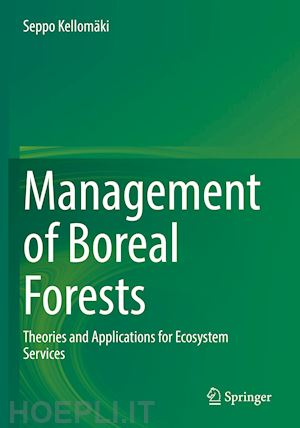

Questo prodotto usufruisce delle SPEDIZIONI GRATIS
selezionando l'opzione Corriere Veloce in fase di ordine.
Pagabile anche con Carta della cultura giovani e del merito, 18App Bonus Cultura e Carta del Docente
This comprehensive textbook explores the boreal forests of Northern Europe, Finland, Sweden and Norway. Students will gain an overview of the forest ecosystem and the services it provides for modern society. From the production of timber, to the supply of food products or their use as a recreational space for human wellbeing – our forests serve many needs. Accordingly, the respective chapters cover various types of ecosystem service, e.g. supporting, provisioning, regulating and cultural services.
The book’s main focus is on the management of boreal forests for the production of these ecosystem services. Addressing modern challenges, e.g. managing vulnerable boreal forests for adaptation to climate change, is an important aspect throughout the volume. Traditional forest management has to adapt and evolve in order to meet the increasing risk of abiotic and biotic damages to our forest biomass. Future forestry graduates will have to face more and more of these challenges; consequently, the book provides them with a wealth of scientific knowhow and possible counter-strategies.
Forestry students in the Northern Hemisphere, be it in Europe, North America or Asia, will find this book an excellent reference guide. To make the content more accessible, it has been enriched with a clear structure, numerous illustrations and learning objectives.
Preface.- Chapter 1. Background - management of forest for varying ecosystem services.- PART I: Forest environment of boreal north and forestry.- Chapter 2. Environmental conditions, site types, and climate change.- PART II: Structure and functioning of selected boreal trees.- Chapter 3. Selected tree species of importance in boreal north.- Chapter 4. Structure of selected trees.- Chapter 5. Regeneration biology of selected trees.- Chapter 6. Physiology, growth and acclimatizing of boreal trees to climate.- PART III: Long-term dynamics of boreal forest ecosystem.- Chapter 7. Successional dynamics of boreal forest ecosystem.- Chapter 8. Management vs ecosystem dynamics.- PART IV: Management strategies, regimes, and operations.- Chapter 9. Preparation of site for natural regeneration and planting in reforestation.- Chapter 10. Natural regeneration in management for regrowth.- Chapter 11. Planting in management for regrowth.- Chapter 12. Management of spacing in pre-commercialphase.- Chapter 13. Management of spacing and thinning in commercial phase.- Chapter 14. Fertilization in management of site fertility.- Chapter 15. Pruning of branches and management of timber quality.- PART V: Management of forest ecosystem for varying services.- Chapter 16. Management strategies for producing different goods and services.- Chapter 17. Dynamics of forest ecosystem vs ecosystem services.- Chapter 18. Risks for forestry under current and warming climate.- Chapter 19. Forest ecosystem services and management under climate change.- Chapter 20. Adaptive management – outlines of theories and practices.- Index.- Appendix: Units and conversions.
The research career of Prof. Seppo Kellomäki has spanned from early 1970s to today. His research activities deal mainly with structure and functioning of boreal forests and sustainable management of boreal forests for varying ecosystem goods and services. His early studies had the focus on multiple use of forest, and management of Scots pine forest for high-quality timber. However, his main contribution in forest science deals with climate change impacts on the dynamics of boreal forest ecosystem in the conditions where forests and forest-based industry are important for the welfare of society. In this context, his focus has been in experimental studies on how the elevating temperature, atmospheric carbon dioxide and changes in precipitation likely effect on the physiology and growth of boreal tree species. These studies have provided a solid bases for modelling. This has made it possible to understand how climate change likely effects on the long-term dynamics of boreal forest ecosystem and how climate change effects on the future forest management. The main questions have been how management should be used and developed for avoiding detrimental effects of successional dynamics and management of boreal forest ecosystem for different ecosystem services. Many of his research papers further address the problems on how forest management and forests should be adapted to climate warming in the boreal conditions, and how management might be used to mitigate warming.











Il sito utilizza cookie ed altri strumenti di tracciamento che raccolgono informazioni dal dispositivo dell’utente. Oltre ai cookie tecnici ed analitici aggregati, strettamente necessari per il funzionamento di questo sito web, previo consenso dell’utente possono essere installati cookie di profilazione e marketing e cookie dei social media. Cliccando su “Accetto tutti i cookie” saranno attivate tutte le categorie di cookie. Per accettare solo deterninate categorie di cookie, cliccare invece su “Impostazioni cookie”. Chiudendo il banner o continuando a navigare saranno installati solo cookie tecnici. Per maggiori dettagli, consultare la Cookie Policy.